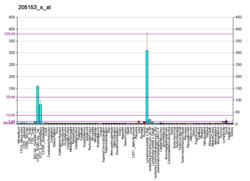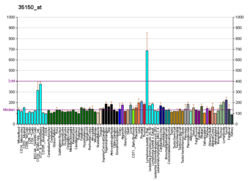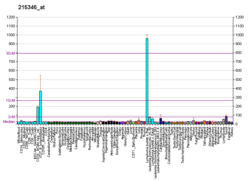Cluster of differentiation 40, CD40 is a type I transmembrane protein found on antigen-presenting cells and is required for their activation. The binding of CD154 (CD40L) on TH cells to CD40 activates antigen presenting cells and induces a variety of downstream effects.
Activated CD4+ T cells primarily exhibit its ligand CD40L/CD154 to antigen-presenting cells including dendritic cells (DCs), B cells, macrophages, classical and non-classical monocytes, on a variety of non-immune cells including platelets and endothelial cells, and on several types of tumor cells.[5]
Mutations affecting this gene are the cause of autosomal recessive hyper-IgM immunodeficiency.
- ^ a b c GRCh38: Ensembl release 89: ENSG00000101017 – Ensembl, May 2017
- ^ a b c GRCm38: Ensembl release 89: ENSMUSG00000017652 – Ensembl, May 2017
- ^ "Human PubMed Reference:". National Center for Biotechnology Information, U.S. National Library of Medicine.
- ^ "Mouse PubMed Reference:". National Center for Biotechnology Information, U.S. National Library of Medicine.
- ^ Salomon R, Dahan R (2022). "Next Generation CD40 Agonistic Antibodies for Cancer Immunotherapy". Frontiers in Immunology. 13: 940674. doi:10.3389/fimmu.2022.940674. PMC 9326085. PMID 35911742.







